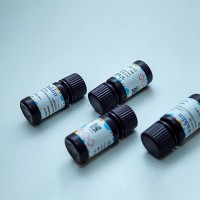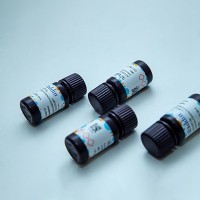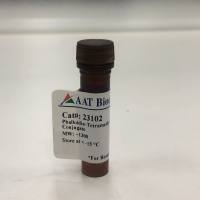|
ABSTRACT |
|
Chromatography on oligo(dT) columns is the preferred method for large-scale purification (>25 µg) of poly(A)+ RNAextracted from mammalian cells. Typically, between 1% and 10% of the RNA applied to the oligo(dT) column is recovered as poly(A)+ RNA. Because the method can be frustratingly slow, it is not recommended for purification of poly(A)+ RNA from multiple samples. For this purpose, batch elution (Protocol 7.4) is the better choice. IMPORTANT: Prepare all reagents used in this protocol with DEPC-treated H2 O. |
|
|
|
MATERIALS |
|
Reagents and Solutions |
Please see Appendix 1 for components of stock solutions, buffers, and reagents. Dilute stock solutions to the appropriate concentrations.
-
Ethanol
-
Ethanol (70%)
-
NaCl (5 M)
-
NaOH (10 N)
-
Elution buffer
-
10 mM Tris-Cl (pH 7.6)
-
1 mM EDTA(pH 8.0)
-
0.05% SDS
The stock solutions of Tris-Cl and EDTAused to make elution buffer should be freshly autoclaved (15 minutes at 15 psi [1.05 kg/cm2 ] on liquid cycle) and then diluted with the appropriate amount of sterile DEPC-treated H2 O. Then add the SDSfrom a concentrated stock solution (10% or 20%) made in sterile DEPC-treated H2 O. IMPORTANT:Do not attempt to sterilize elution buffer by autoclaving because it froths excessively.
-
2x Oligo(dT)-cellulose loading buffer
-
40 mM Tris-Cl (pH 7.6)
-
1 M NaCl
-
2 mM EDTA (pH 8.0)
-
0.2% (w/v) sodium lauryl sarcosinate
-
Prepare as described below.
Make up Tris-Cl (pH 7.6) from a fresh bottle in autoclaved, DEPC-treated H2 O. Prepare NaCl and EDTA in 0.1% DEPC in H2 O. Store for at least 12 hours at 37°C and autoclave the mixture for 15 minutes at 15 psi (1.05 kg/cm2 ) on liquid cycle. To prepare sterile loading buffer, mix appropriate amounts of RNase-free stock solutions of Tris-Cl (pH 7.6), NaCl, and EDTA (pH 8.0) in an RNase-free container. Allow the solution to cool to approximately 65°C and then add sodium lauryl sarcosinate from a 10% stock solution that has been heated to 65°C for 30 minutes.
Alternatively, substitute 0.05 M sodium citrate for Tris-Cl and treat the sodium citrate/NaCl/ EDTA mixture and sodium lauryl sarcosinate with DEPC(please see Protocol 7.1). Store loading buffer at room temperature.
-
Sodium acetate (3 M, pH 5.2)
-
Sterile, DEPC-treated H2 O (see MC3, p. 7.84)
|
|
Nucleic Acids/Oligonucleotides
|
Centrifuges/Rotors/Tubes
-
Sorvall SS-34 rotor (4°C)
|
Additional Items
-
Cuvettes, for measuring absorbance at 260 nm
-
Dispo column or pasteur pipette plugged with sterile glass wool
Before use, treat Dispo column with DEPC. Sterilize the plugged pasteur pipette by baking for 4 hours at 300°C.
-
Oligo(dT)-cellulose, usually purchased commercially as a dried powder
Columns of oligo(dT)-cellulose can be stored at 4°C and reused many times. Between uses, the column should be regenerated by sequential washing with NaOH, H2 O, and loading buffer as described in Steps 1-3 of this protocol. Spun columns of oligo(dT)-cellulose are available from several manufacturers.
-
pH paper (pH test strips)
-
Water bath (65°C)
|
|
|
METHOD
|
-
Suspend 0.5-1.0 g of oligo(dT)-cellulose in 0.1 N NaOH
-
Pour a column of oligo(dT)-cellulose (0.5-1.0-ml packed volume) in a DEPC-treated Dispo column (or a pasteur pipette, plugged with sterile glass wool and sterilized by baking for 4 hours at 300°C). Wash the column with 3 column volumes of sterile DEPC-treated H2 O.
-
Wash the column with sterile 1x oligo(dT)-cellulose-loading buffer (dilute from 2x stock using sterile DEPC-treated H2 O) until the pH of the effluent is <8.0. Use pH paper for this measurement.
-
Dissolve the RNA in sterile H2 O and heat the solution to 65°C for 5 minutes. Cool the solution to room temperature quickly and add 1 volume of 2x oligo(dT)-cellulose-loading buffer.
-
Apply the solution of RNA to the column and, in a sterile tube, immediately begin to collect the material flowing through the column. When all of the RNA solution has entered the column, wash the column with 1 column volume of 1x oligo(dT)-cellulose-loading buffer while continuing to collect the flow-through.
-
When all of the liquid has emerged from the column, heat the collected flow-through to 65°C for 5 minutes and reapply it to the top of the column. Again collect the material flowing through the column.
-
Wash the column with 5-10 column volumes of 1x oligo(dT)-cellulose-loading buffer, collecting 1-ml fractions into sterile plastic tubes (e.g., microfuge tubes).
-
Use quartz or disposable methacrylate cuvettes to measure the absorbance at 260 nm of a 1:20 dilution of each fraction collected from the column using 1x oligo(dT)-cellulose loading buffer as a blank.
-
Precipitate the fractions containing a majority of the OD260 material by the addition of 2.5 volumes of ethanol at -20°C.
-
Elute the poly(A)+ RNA from the oligo(dT)-cellulose with 2-3 column volumes of sterile, RNase-free elution buffer. Collect fractions equivalent in size to one third of the column volume.
-
Use quartz or disposable methacrylate cuvettes to measure the absorbance at 260 nm of each fraction collected from the column. Pool the fractions containing the eluted RNA.
-
To purify poly(A)+ RNA further, heat the preparation of RNA to 65°C for 3 minutes and then cool it quickly to room temperature. Adjust the concentration of NaCl in the eluted RNA to 0.5 M using 5 M NaCl and carry out a second round of chromatography on the same column of oligo(dT)-cellulose (i.e., repeat Steps 3 and 5-11).
The material obtained after a single round of chromatography on oligo(dT)-cellulose usually contains approximately equal amounts of polyadenylated and nonpolyadenylated species of RNA. Polyadenylated RNA may be further purified as described by a second round of chromatography on oligo(dT)-cellulose.
-
To the poly(A)+ RNA eluted from the second round of oligo(dT)-cellulose chromatography, add 3 M sodium acetate (pH 5.2) to a final concentration of 0.3 M. Mix well. Add 2.5 volumes of ice-cold ethanol, mix, and store the solution for at least 30 minutes on ice.
-
Recover the poly(A)+ RNA by centrifugation at 10,000g (9000 rpm in a Sorvall SS-34 rotor) for 15 minutes at 4°C. Carefully discard the supernatant, and wash the pellet (which is often invisible) with 70% ethanol. Recentrifuge briefly, remove the supernatant by aspiration, and store the open tube in an inverted position for a few minutes to allow most of the residual ethanol to evaporate. Do not allow the pellet to dry.
-
Redissolve the damp pellet of RNA in a small volume of sterile, DEPC-treated H2 O. Use quartz or disposable methacrylate cuvettes to measure the absorbance at 260 nm of each fraction collected from the column. Pool the fractions that contain RNA.
-
Store the preparation of poly(A)+ RNA.
|







